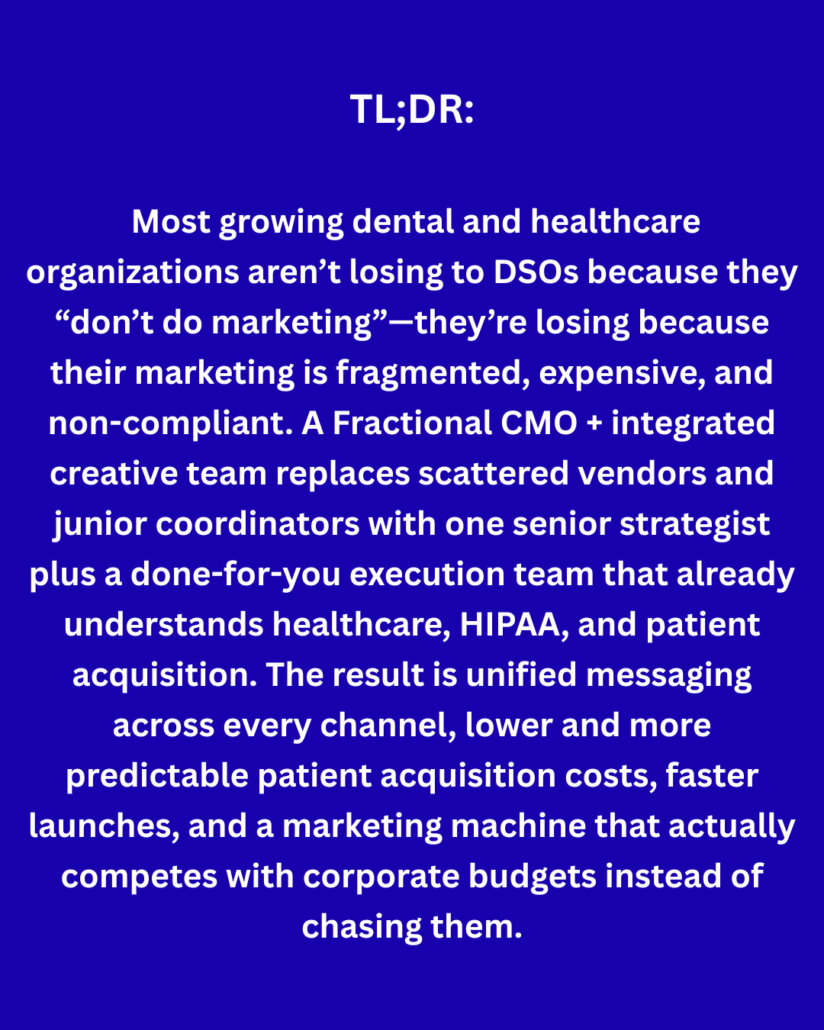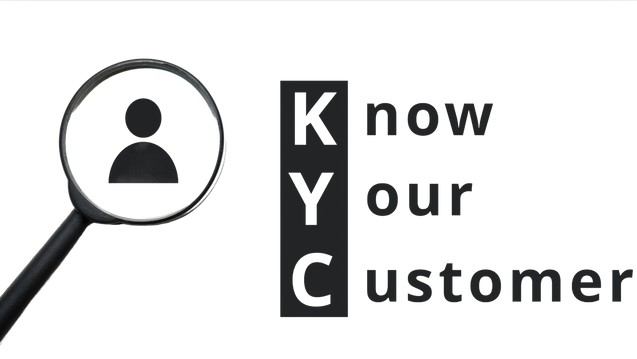Fractional CMO + Creative Team: Healthcare Growth Model
Why High-Growth Healthcare Companies Are Abandoning Agencies for an All-in-One Strategic Engine
Your practice is growing. Maybe you’ve got multiple locations or you’re planning to expand. Patient volume is decent.
But here’s the problem that keeps you up at night: your marketing feels like herding cats in a thunderstorm.
You’ve got a web designer who takes three weeks to update a landing page. A social media person posting random content. An SEO consultant sending reports you don’t understand. Maybe a videographer you found on Facebook who ghosted you after shooting one patient testimonial.
Nobody’s talking to each other. Nothing connects. And you—the CEO or owner—are stuck in the middle, trying to translate between all these vendors while also running your actual business.
Oh, and let’s not forget:
- Patient acquisition costs keep climbing
- The DSO down the street just opened with a massive marketing budget
- Your online reviews need constant attention
- Every marketing piece needs HIPAA review before it goes live
- Insurance reimbursements keep shrinking while your marketing spend grows
Sound familiar?

Most healthcare and dental organizations don’t fail because they’re not doing marketing. They fail because their marketing is completely fragmented.
It’s not a system. It’s a scavenger hunt with a Black Card.
And it’s exactly why smart healthcare CEOs are shifting to a completely different model: the Fractional CMO + Creative Team.
Let me show you why this model is quietly becoming the unfair advantage for practices and health organizations serious about predictable growth—especially in a market where DSOs and corporate healthcare are outspending independent practices 10-to-1.
What Is the Fractional CMO + Creative Team Model?
Before we dive into why this works, let’s get clear on what this actually is.
A Fractional CMO is a senior marketing executive who works with your organization part-time. Think C-suite level strategic thinking without the $250K salary, benefits, equity package, and six-month ramp-up period.
But here’s where it gets interesting.
Most fractional CMOs work alone. They give you strategy, hand you a beautiful roadmap, and say “good luck finding people to execute this while maintaining HIPAA compliance.”
The Fractional CMO + Creative Team model is different.
You get the strategic brain—the CMO who builds your roadmap, owns your positioning, and knows how to compete against well-funded DSOs—plus an integrated creative team that can actually execute everything under healthcare compliance requirements.
Same ecosystem. Same vision. One unified force.
It’s like having a full marketing department that understands HIPAA, patient acquisition, and reputation management, minus the office politics, hiring headaches, and massive overhead.
You Finally Get Real Strategy (From Someone Who Actually Knows How to Build One)
Here’s what typically happens when a dental practice or healthcare organization hires a marketing agency:
They start with tactics.
“Let’s run some Google Ads!”
“You need more social media!”
“Let’s redesign your website!”
But nobody asks the important questions first:
- Who exactly are we targeting, and why should they choose us over the DSO with the billboard on the highway?
- What makes us different when every practice says “caring, compassionate, state-of-the-art”?
- Which marketing channels will actually drive new patients without blowing our acquisition costs through the roof?
- How do we compete when corporate practices have 10x our marketing budget?
- How do we build trust online when one bad review can tank our reputation?
- What should we build first, second, and third—and how does this all tie to revenue goals?

A Fractional CMO starts with alignment, forecasting, positioning, audience design, and channel strategy.
Before a single ad runs or a single post goes live, you get:
- A 12-18 month marketing roadmap that ties directly to revenue targets and patient acquisition goals
- Competitive positioning that differentiates you from DSOs and corporate practices
- Priority sequencing (what to tackle first and why—not just what’s trendy on LinkedIn)
- A measurable, revenue-focused plan built on realistic patient acquisition costs, not vanity metrics
- Messaging that actually sets you apart from every other practice in your market
- A reputation management strategy that turns reviews into your competitive advantage
This is the strategic layer that freelancers, junior marketing coordinators, and most agencies simply aren’t equipped to build—especially in healthcare where compliance and reputation are everything.
Real-world example: A multi-location dental group was watching patient acquisition costs climb to $400+ per new patient while a nearby DSO was dominating local search. Their fragmented marketing approach led to different messaging at each location, an inconsistent online presence, and no clear positioning against corporate competitors. After bringing in strategic leadership through a Fractional CMO + Creative Team model, they repositioned around a specific patient demographic (families who value personalized care over corporate convenience), unified their brand across locations, and built a reputation management system that showcased their difference. Patient acquisition costs dropped to $240 within six months, and they started winning the “mom research” battle against the DSO.
Then You Get Instant Execution—Without Hiring a 6-Person Internal Team
Here’s where this model moves from “interesting” to “game-changing.”
Strategy without execution is just a fancy PDF that sits in your Google Drive while your competitors keep stealing your patients.
Most fractional CMOs leave you to figure out the execution part. You’re back to hiring freelancers, begging your niece who “knows Canva,” or trying to train someone internally who’s never done healthcare marketing before.
And here’s what makes healthcare execution even harder:
- Every piece of content needs HIPAA review
- Patient testimonials require proper consent and releases
- Before-and-after photos have specific regulations
- Claims about procedures need to be carefully worded
- Online reputation requires constant monitoring
- Video content needs to feel authentic, not corporate
With the Fractional CMO + Creative Team model, you get both strategy and execution under one roof:
- Graphic designers (who understand healthcare branding, HIPAA compliance, and how to compete visually against DSO marketing)
- Copywriters (who can write patient-facing content that converts without making illegal claims)
- SEO specialists (who know local search for healthcare and how to outrank corporate practices)
- Video producers (because video is no longer optional—it’s how patients research you)
- Content strategists (who plan months ahead with compliance built in)
- Social media + distribution experts (who understand healthcare advertising restrictions)
- Reputation management specialists (who monitor and respond to reviews strategically)
No more chasing vendors.
No more training junior staff on HIPAA.
No more duct-taping deliverables together and hoping they’re compliant.
The Fractional CMO leads the strategy.
The creative team executes the strategy.
You get speed plus accuracy plus compliance without the payroll burden.
Think about what this means practically:
- Need a HIPAA-compliant patient education video series? Done in two weeks, not two months.
- Need your website rewritten with clear positioning against DSOs? Handled with proper compliance review.
- Need a 6-month content calendar for SEO and social? Mapped, created, and scheduled.
- Need reputation management protocols for responding to reviews? Built and monitored.
- Need email campaigns for patient reactivation? Created and deployed with proper opt-in management.
All from people who already understand your strategy, your compliance requirements, and your competitive landscape.
Every Marketing Channel Finally Pulls in the Same Direction
Let’s talk about what happens when your marketing is fragmented—especially when you’re competing against well-funded DSOs.
Your website says you’re “comprehensive and caring.”
Your Google Ads say you’re “affordable and convenient.”
You’re posting generic dental memes on social media.
Your SEO blog is keyword-stuffed articles written by someone who’s never set foot in a dental office.
Your video content looks like it’s from a completely different practice.
Your reviews are all over the place because no one is managing your reputation strategically.
Meanwhile, the DSO down the street has consistent branding everywhere, a unified message, and they’re outspending you 10-to-1.
When your brand, SEO, video, social, website, messaging, and reputation management come from different people who’ve never talked to each other, you end up with:
- Inconsistent tone (sounds professional here, casual there, corporate over there)
- Misaligned visuals (your brand doesn’t look like a brand—it looks like a DIY project)
- Conflicting priorities (everyone’s pushing their own agenda instead of patient acquisition)
- Weak positioning against DSOs (you can’t compete on budget, so you need to compete on message—but what IS your message?)
- Lost revenue (because confused patients book with the DSO that seems more “together”)
When everything comes from one strategic brain with one unified creative team, you get:
- Messaging that compounds (every touchpoint reinforces the same positioning against corporate competition)
- Content that reinforces your brand story (not random posts about National Smile Day)
- Videos that match your visual identity and message (cohesive, professional, authentic)
- SEO content built on the same strategy as your social content and your reputation management (everything works together)
- A website that actually converts because the message is crystal clear: “Here’s why we’re different from the corporate place”
- Reputation management that turns reviews into a competitive weapon (responding strategically, showcasing your difference)
It feels like someone finally turned all the lights on.
Patients start saying things like, “Your practice really stands out,” or “I can tell you’re not like those chain dentists,” or “Your online reviews made me feel like I’d be cared for as a person, not a number.”
That doesn’t happen by accident. It happens when strategy, execution, and reputation management are unified.


It Removes 90% of Your Marketing Risk (Especially the Compliance Kind)
Let’s be honest: hiring for marketing in healthcare is a gamble with really expensive stakes.
You hire a marketing coordinator. Six months in, you realize they’re in over their head—and they just posted something on Instagram that might be a HIPAA violation.
You hire an agency. They create gorgeous content. Then you find out they’ve been making claims about procedures that aren’t FDA-approved language.
You hire a CMO full-time. They don’t understand healthcare compliance. Eighteen months and $300K later, they’re gone and you’re starting over.
The Fractional CMO + Creative Team model reduces risk in four specific ways:
Risk #1: Compliance Failures
Healthcare marketing has landmines everywhere. HIPAA violations. Improper patient testimonials. Misleading procedure claims. A unified team with healthcare experience knows these rules inside and out. Your content gets created right the first time.
Risk #2: Underperformance
If a campaign or channel underperforms, the same team diagnoses it and fixes it. No fingerpointing between your SEO person, your web developer, and your ad manager. No “well, the design was fine—your copy must be the problem.” One team owns the entire patient acquisition funnel.
Risk #3: Onboarding Churn
Every time you hire a new vendor or employee, there’s a 30-90 day learning curve. They need to understand your brand, your patients, your clinical capabilities, HIPAA requirements, your competitors, and your goals. With an integrated team, that learning curve happens once. Every project after that builds on existing knowledge.
Risk #4: The Vendor Blame Game
When your SEO consultant blames your web developer, who blames your content writer, who blames your designer, who blames your social media manager—you lose time and money. With one unified team, there’s no blame game. One team owns everything from strategy to execution to results.
Execution becomes consistent.
Compliance is baked in.
Results become predictable.
Your marketing stops feeling like a high-stakes gamble.
You Scale Faster—With Way Less Chaos (And You Can Actually Compete with DSOs)
Here’s what happens when strategy and execution live in the same ecosystem:
Your company can move fast without breaking things or breaking compliance.
- Launch campaigns 3-5x faster (no waiting for vendor schedules or compliance reviews from five different people)
- Spin up video content at scale (patient testimonials with proper releases, procedure explainers, doctor intros, office tours)
- Dominate your local market with unified content (SEO blogs that support your social posts that support your ads that support your reputation strategy)
- Create a recognizable brand that competes with DSO marketing (because everything compounds instead of contradicting)
- Build an actual marketing machine instead of reinventing the wheel every quarter and playing catch-up

This is how mid-market healthcare companies and multi-location dental groups go from “stalling at $5M while DSOs eat our lunch” to “predictably hitting $10M, then $20M while maintaining our independence.”
The marketing isn’t the bottleneck anymore. It’s the accelerant. It’s the competitive advantage.
Example: A regional dental group wanted to open three new locations in 18 months to compete with DSO expansion in their market. Their old agency model couldn’t keep up—every new location meant re-onboarding, re-explaining, restarting the whole process. With a Fractional CMO + Creative Team model, they built a replicable playbook. Each new location launched with a complete marketing system from day one: brand-consistent website pages, local SEO optimized for each market, patient-acquisition campaigns targeting families who value personalized care, reputation management protocols, and video content featuring each location’s team to humanize the brand against corporate competitors. They hit their growth targets six months early and successfully defended against DSO market share gains.
The Bottom Line: This Is How Smart Healthcare CEOs Are Winning Against Corporate Competition
If you want faster growth without the bloat of a marketing department—and without the chaos of juggling five different agencies and freelancers who don’t understand HIPAA or how to compete with DSOs—the Fractional CMO + Creative Team model is the most efficient, highest-leverage option available today.
It gives you:
✅ The strategy of a C-suite marketing executive who understands healthcare
✅ The horsepower of a full creative agency with compliance expertise
✅ The alignment of a single unified team
✅ Positioning that helps you compete with corporate healthcare marketing budgets
✅ Reputation management that turns reviews into a competitive weapon
When these forces combine, marketing stops feeling like throwing money at a wall and hoping something sticks while the DSO steals your patients.
It becomes a predictable growth engine—even when you’re competing against practices with 10x your budget.
Key Takeaways
- Fragmented marketing kills growth, especially against DSOs. Multiple vendors who don’t communicate create inconsistent messaging, compliance risks, wasted budget, and lost opportunities to well-funded corporate competitors.
- Strategy without execution is worthless in healthcare. A Fractional CMO gives you the roadmap and competitive positioning, but you need a team to actually execute it while maintaining HIPAA compliance.
- Integration creates compound growth against corporate competition. When every marketing channel pulls in the same direction with unified messaging, your brand becomes recognizable, and your positioning becomes powerful enough to compete with DSOs.
- Risk drops dramatically—including compliance risk. One unified team with healthcare experience means no onboarding churn, no vendor blame game, no HIPAA violations, and consistent execution.
- You scale faster with less chaos. Healthcare organizations using this model can launch campaigns 3-5x faster, open new locations without marketing becoming the bottleneck, and compete effectively against corporate healthcare expansion.
- Patient acquisition costs become predictable. Instead of watching costs spiral while you juggle vendors, you get strategic focus on the channels and messages that actually drive quality patients at sustainable costs.
Frequently Asked Questions (FAQs)
- How is a Fractional CMO different from hiring a marketing agency?
A marketing agency typically focuses on execution (running ads, creating content, managing social media). A Fractional CMO focuses on strategy first—building your roadmap, positioning against competitors like DSOs, and creating a growth plan that addresses patient acquisition costs and reputation management. With the Fractional CMO + Creative Team model, you get both: strategic leadership plus execution, all under one roof with complete alignment and healthcare compliance expertise.
- Is this model only for large healthcare organizations?
Not at all. This model works exceptionally well for mid-market healthcare and dental organizations ($3M-$50M in revenue) who’ve outgrown the “DIY marketing” phase but aren’t ready to build a full internal department. It’s perfect for multi-location practices facing DSO competition, specialty clinics needing to differentiate, and regional health service organizations fighting patient acquisition cost increases.
- How does this model handle HIPAA compliance and healthcare regulations?
Healthcare compliance is built into the process, not added as an afterthought. The team has experience with HIPAA requirements, patient testimonial releases, proper claims language, and healthcare advertising restrictions. Every piece of content is created with compliance in mind from the start, and review protocols are already established—no more worrying about whether your social media post creates legal exposure.
- How quickly can we expect to see results?
Strategy development and competitive analysis typically take 30-45 days. Execution and initial campaign launches happen within 60-90 days. Most organizations see measurable improvements in patient acquisition costs and brand consistency within the first quarter, with compounding growth accelerating in quarters 2-4 as the full system takes effect and reputation management begins to show results.
- What if we already have some internal marketing staff?
Perfect. The Fractional CMO can lead and mentor your internal team, filling the strategic leadership gap while the creative team handles specialized execution (video production, advanced design, SEO technical work, reputation management) that your internal staff may not have bandwidth or expertise for. Many organizations use this as a “build and train” model—eventually bringing more capabilities in-house once the system is proven and your team is trained.
Conclusion: It’s Time to Stop Juggling and Start Competing
If you’re reading this, you probably already know your current marketing setup isn’t working the way it should.
Maybe you’re frustrated watching patient acquisition costs climb while the DSO down the street seems to have unlimited budget.
Maybe you’re tired of being the middleman between five different contractors who don’t understand healthcare.
Maybe you’re losing the reputation battle because nobody’s strategically managing your online presence.
Maybe you’ve tried hiring internally and watched good people fail because they didn’t have the right leadership, support, or healthcare marketing expertise.
Here’s the truth: you can’t out-execute a broken strategy, and you can’t wait around for a perfect strategy that never gets implemented while your competitors steal your market share.
You need both. At the same time. Working together. With healthcare compliance baked in.
The Fractional CMO + Creative Team model gives you exactly that.
It’s not flashy. It’s not trendy. But it works.
And in a competitive healthcare market where patients have endless options, DSOs are expanding aggressively, and one compliance mistake can cost you everything, having a unified marketing machine isn’t just nice to have.
It’s how you survive. It’s how you grow. It’s how you win.
Ready to Build Your Marketing Machine with Luce Media?
At Luce Media, we’ve helped healthcare and dental organizations just like yours compete effectively against DSOs, reduce patient acquisition costs, and build predictable growth engines through the Fractional CMO + Creative Team model.
If you’re a healthcare or dental CEO tired of fragmented marketing and ready to build a system that actually works, let’s talk.
Schedule a free 30-minute strategy consultation with Luce Media to see if this model is right for your organization. We’ll audit your current marketing approach, identify your biggest competitive opportunities (especially against DSOs), analyze your patient acquisition costs, and map out exactly what a unified system would look like for you.
No pushy sales pitch. No generic agency promises. Just straight talk about what’s working, what’s not, and what’s actually possible when strategy and execution are unified under one roof.
Because the practices that win aren’t the ones with the biggest budgets.
They’re the ones with the smartest systems.




